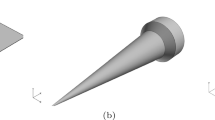Abstract
With an interest in developing and studying the stability of laminar undisturbed basic-state solutions, this work is focused on accurately modeling the laminar flowfield of the boundary layer transition (BOLT) geometry under nominal and off-nominal conditions (i.e., nonzero angles of pitch and yaw). The BOLT flowfield is studied using the DPLR flow solver with MUSCL Steger–Warming fluxes using a set of five grids at different resolutions and identical grid topologies. A total of three different sets of conditions are studied: two flight conditions and one wind-tunnel-scale (33%) condition. (1) For the two sets of nominal flight operating conditions, it is found that the flow structures in the centerline region of BOLT are similar to those found in prior studies including in shape, location, and extent both vertically and spanwise, but a detailed comparison of velocity contours shows that further quantitative convergence studies are warranted. The centerline region, however, extends to at most 4 cm in semi-span at the aft end of the geometry (20% of the semi-span). Away from the centerline and where wind-tunnel-scale results have observed regions of possibly transitional behavior, the laminar flowfield converges with high accuracy. (2) For nominal wind-tunnel operating conditions, all grid resolutions simulated show good agreement in most regions as compared with prior results, with any differences falling within the scatter of existing experimental and DNS results. Aside from this focus, boundary-layer stability is examined outboard of the centerline region at nonzero pitch and yaw for a flight case, and second mode and stationary crossflow instabilities are considered. Second-mode instability is found to be locally significant at certain pitch and yaw angles particularly downstream of the swept leading edges. In addition, stationary crossflow is found to become highly amplified in significant wedges extending to the aft end of the BOLT geometry, with N-factors consistent with those found for HIFiRE-5b associated with transitional flow. The reasons for amplification of these different instabilities are also investigated from a physics-based perspective.





















Similar content being viewed by others
References
Leyva, I.A., Cummings, R.M.: Introduction to the special section on the boundary layer transition (BOLT) flight experiment. J. Spacecr. Rockets 58(1), 4–5 (2021). https://doi.org/10.2514/1.A34872
Wheaton, B.M., Berridge, D.C., Wolf, T.D., Araya, D.B., Stevens, R.T., McGrath, B.E., Kemp, B.L., Adamczak, D.W.: Final design of the boundary layer transition (BOLT) flight experiment. J. Spacecr. Rockets 58(1), 6–17 (2021). https://doi.org/10.2514/1.A34809
McKiernan, G.R., Chynoweth, B.C., Schneider, S.P., Berridge, D.C., Wheaton, B.M.: Boundary layer transition preflight experiments in a Mach-6 quiet tunnel. J. Spacecr. Rockets 58(1), 54–66 (2021). https://doi.org/10.2514/1.A34772
Kostak, H.E., Bowersox, R.D.W.: Preflight ground test analyses of the boundary layer transition (BOLT) flight geometry. J. Spacecr. Rockets 58(1), 67–77 (2021). https://doi.org/10.2514/1.A34858
Thome, J., Dwivedi, A., Nichols, J.W., Candler, G.V.: Direct numerical simulation of BOLT hypersonic flight vehicle. AIAA (2018). https://doi.org/10.2514/6.2018-2894
Knutson, A.L., Thome, J.S., Candler, G.V.: Numerical simulation of instabilities in the boundary-layer transition experiment flowfield. J. Spacecr. Rockets 58(1), 90–99 (2021). https://doi.org/10.2514/1.A34599
Cook, D.A., Thome, J., Nichols, J.W., Candler, G.V.: Receptivity analysis of BOLT to distributed surface roughness using input-output analysis. AIAA (2019). https://doi.org/10.2514/6.2019-0089
Moyes, A.J., Reed, H.L.: Preflight boundary-layer stability analysis of BOLT geometry. J. Spacecr. Rockets 58(1), 78–89 (2021). https://doi.org/10.2514/1.A34792
Mullen, C.D., Moyes, A., Kocian, T.S., Reed, H.L.: Heat transfer and boundary-layer stability analysis of subscale BOLT and the fin cone. AIAA (2019). https://doi.org/10.2514/6.2019-30819-3081
Li, F., Choudhari, M.M., Paredes, P.: Streak instability analysis on BOLT configuration. AIAA (2020). https://doi.org/10.2514/6.2020-3028
Mullen, C.D., Reed, H.L.: Linear parabolized stability analysis of the BOLT flight geometry at off-nominal conditions. AIAA (2020). https://doi.org/10.2514/6.2020-3027
Wright, M.J., Candler, G.V., Bose, D.: Data-parallel line relaxation method for the Navier–Stokes equations. AIAA J. 36(9), 1603–1609 (1998). https://doi.org/10.2514/2.586
Moyes, A.J., Kocian, T.S., Mullen, D., Reed, H.L.: Boundary-layer stability analysis of HIFiRE-5b flight geometry. J. Spacecr. Rockets 55(6), 1341–1355 (2018). https://doi.org/10.2514/1.A34146
Kocian, T.: Computational hypersonic boundary-layer stability and the validation and verification of EPIC. Ph.D. thesis, Texas A&M University (2018)
Oliviero, N.B., Kocian, T.S., Moyes, A., Reed, H.L.: EPIC: NPSE analysis of hypersonic crossflow instability on yawed straight circular cone. AIAA (2015). https://doi.org/10.2514/6.2015-2772
Moyes, A., Beyak, E., Kocian, T.S., Reed, H.L.: Accurate and efficient modeling of boundary-layer instabilities. AIAA (2019). https://doi.org/10.2514/6.2019-1907
Li, F., Choudhari, M., Chang, C.L., Kimmel, R., Adamczak, D., Smith, M.: Transition analysis for the HIFiRE-1 flight experiment. AIAA (2011). https://doi.org/10.2514/6.2011-3414
Mack, L.: Boundary-layer linear stability theory. AGARD Report 709: Special Course on Stability and Transition of Laminar Flow. VKI, Brussels (1984)
Zurigat, Y.H., Nayfeh, A.H., Masad, J.A.: Effect of pressure gradient on the stability of compressible boundary layers. AIAA J. 30(9), 2204–2211 (1992). https://doi.org/10.2514/3.11206
Acknowledgements
The computational work on the BOLT and BOLT-II geometries is supported by AFRL/AFOSR under grant numbers FA9550-18-1-0010 and FA9550-19-1-0154, respectively, with program officers Drs. Ivett Leyva and Sarah Popkin. The authors are grateful to Pointwise and NASA for providing the Pointwise meshing program and the DPLR CFD code, respectively. The authors also acknowledge the Texas Advanced Computing Center (TACC) at The University of Texas at Austin for providing high performance computing (HPC) and storage resources that have contributed to the research results reported within this paper. In addition, portions of this research were conducted with the advanced computing resources provided by Texas A&M High Performance Research Computing.
Author information
Authors and Affiliations
Corresponding authors
Additional information
Communicated by Pino Martin.
Publisher's Note
Springer Nature remains neutral with regard to jurisdictional claims in published maps and institutional affiliations.
Rights and permissions
About this article
Cite this article
Mullen, C.D., Reed, H.L. Computational modeling and stability analysis of BOLT hypersonic geometry including off-nominal conditions. Theor. Comput. Fluid Dyn. 36, 251–276 (2022). https://doi.org/10.1007/s00162-021-00583-x
Received:
Accepted:
Published:
Issue Date:
DOI: https://doi.org/10.1007/s00162-021-00583-x




